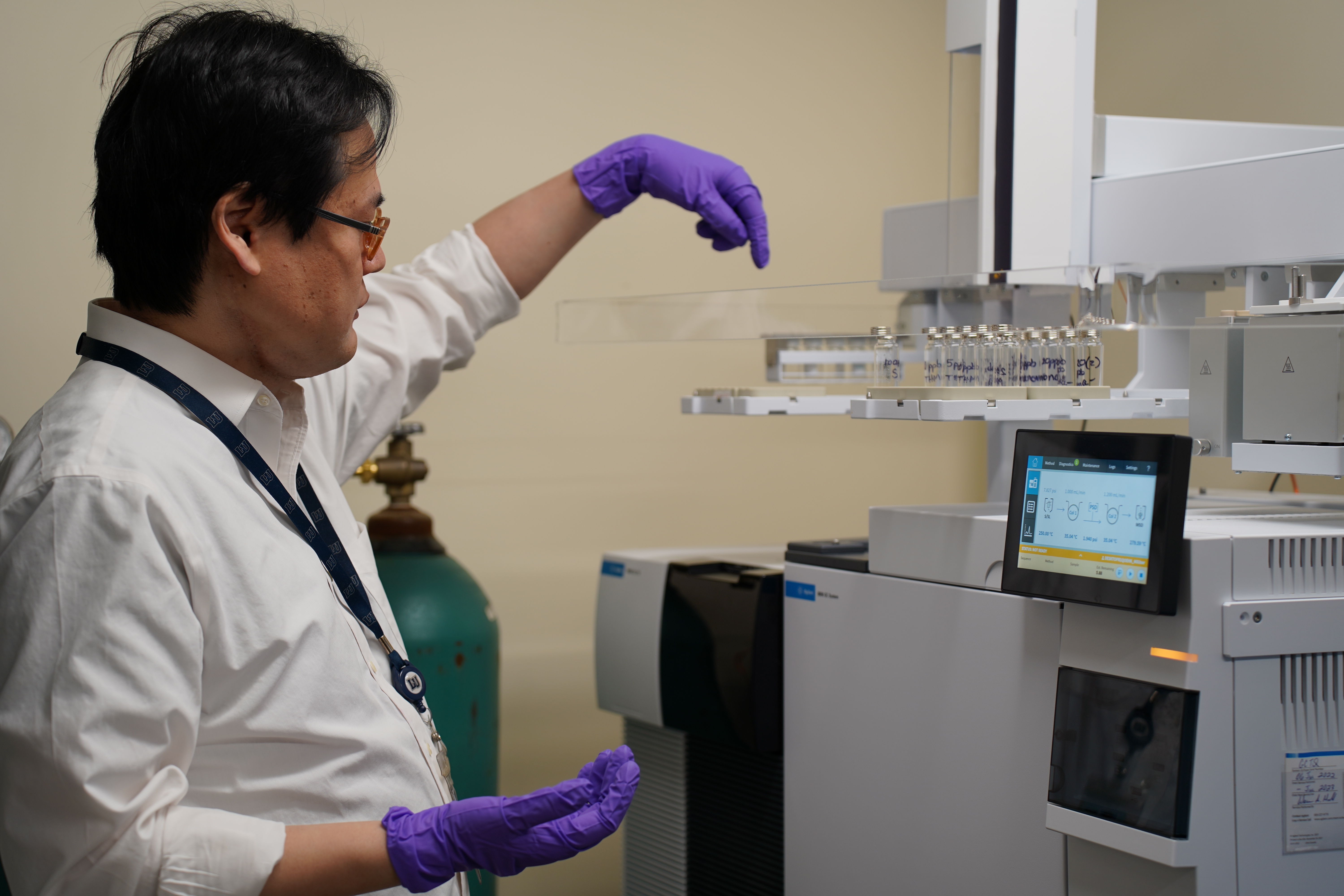LU Researchers Pioneer Innovative Food Safety Monitoring Device
Office of Communications and Marketing
Young Hall
820 Chestnut Street
Jefferson City, MO 65101
 Dr. Qingbo (Roger) Yang of LU Cooperative Research (pictured) and researchers at Lincoln University (LU) of Missouri’s College of Agriculture, Environmental and Human Sciences (CAEHS) are working on a new way to determine food safety quickly by developing a portable sensor system for on-site food safety monitoring.
Dr. Qingbo (Roger) Yang of LU Cooperative Research (pictured) and researchers at Lincoln University (LU) of Missouri’s College of Agriculture, Environmental and Human Sciences (CAEHS) are working on a new way to determine food safety quickly by developing a portable sensor system for on-site food safety monitoring.
Is That Safe to Eat? LU Researchers Pioneer Innovative Food Safety Monitoring Device
Imagine the chef at your favorite restaurant preparing a salad for guests. Inspecting the produce to be used, he sniffs at an avocado. Is it safe to use? Knowing the answer quickly could help prevent and control foodborne disease outbreaks.
That’s the goal of researchers at Lincoln University (LU) of Missouri’s College of Agriculture, Environmental and Human Sciences (CAEHS) who are working on a new way to determine food safety quickly. They are making headway in analytical chemistry by developing a portable sensor system for on-site food safety monitoring — the first of its kind. Through this new technology and process, food safety risks will be detected in hours, if not minutes, instead of days or weeks. At present, no such sensors are commercially available, and Lincoln University is at the forefront of related research.

Researchers at Lincoln University of Missouri are developing a portable sensor system for on-site food safety monitoring — the first of its kind.
“Although portable sensors have been reported elsewhere, most of them are still relying on conductivity/permittivity changes or antibody-antigen reactions to detect simple and fixed pathogen(s),” said Assistant Professor Dr. Qingbo (Roger) Yang of LU Cooperative Research, the principal investigator of the USDA-NIFA funded project. “We are advancing the detection paradigm by pairing advanced sensing technologies with powerful machine learning tools.”
According to Yang, there is a critical need for rapid detection methods to monitor food safety issues. Traditional methods used to test food samples can be a long process (e.g., gel culturing, colony formation, DNA/RNA extraction, PCR screening, etc.), lasting from a few days to a couple of weeks. The elapsed time for testing results is often too late to prevent contaminated food from being consumed by the public.
“Foodborne pathogen caused issues increased during the COVID-19 pandemic, with lack of labor and protection measures in a time of a food shortage,” Yang said. “This has caused acts of neglect in the food process, leading to a rise in foodborne diseases over the past few years."

“LU’s innovative sensor can ‘smell’ and pick up the specific molecules that exist in the targeted food — even in very small amounts — with the assistance of a well-trained machine learning algorithm,” said Dr. Qingbo (Roger) Yang.
Yang and his team at LU are developing a portable, hand-held sensing device with a specially designed Raman spectroscopic sensor, which embedded within a bionic chamber mimics the functioning structure of our human olfactory system (noses). Contaminated food samples placed underneath the chamber will emit the so-called “volatile organic compounds” (VOCs), which act as molecular fingerprints for specific foodborne pathogens. For example, pathogenic E. coli discharges one particular VOC, indole (C8H7N). The detection of the VOC by the device will provide readily information if the food contains the dangerous pathogen or not.
“LU’s innovative sensor can ‘smell’ and pick up the specific molecules that exist in the targeted food — even in very small amounts — with the assistance of a well-trained machine learning algorithm,” said Yang. “The portable sensor is currently being ‘trained’ to quickly assess a panel of such VOCs that are correlated with major foodborne pathogens such as E. coli, salmonella, listeria and so on.”
At present, the first-generation sensor has been tested with collaborative lab. An upgraded version will be built on LU campus this summer.
Moreover, suspicious or confirmed food samples “fished” by the sensing device can further be examined in the backstage laboratory for high-throughput, high-accuracy screening, using two major analytical instruments that are unique to Lincoln University: the Ultra-High Performance Liquid Chromatography tandem Mass Spectrometer (UHPLC-MS/MS) and Gas Chromatography tandem Mass Spectrometer (GC-MS/MS). Results are not only qualitative but also quantitative, showing even trace amounts of chemicals at concentrations down to the part per trillion (ppt) level.
Prospective goals for this project include rapid and sustainable sensing strategies for preventing and controlling foodborne disease outbreaks in Missouri and other states. The same technology can also play a huge role in the fields of pesticides residue monitoring, nutrition and soil health, military hazardous chemicals investigation, gas leakage, biomedical diagnostics, fermentation industrial and so on.
This project is financially supported through the USDA NIFA-funded Evans-Allen Research Program, from February 2021 to January 2024. Dr. Yang of LU Cooperative Research is a forerunner on many of these CAEHS initiatives. For more information, contact Dr. Yang at 573-681-5036 or YangQ@LincolnU.edu.
